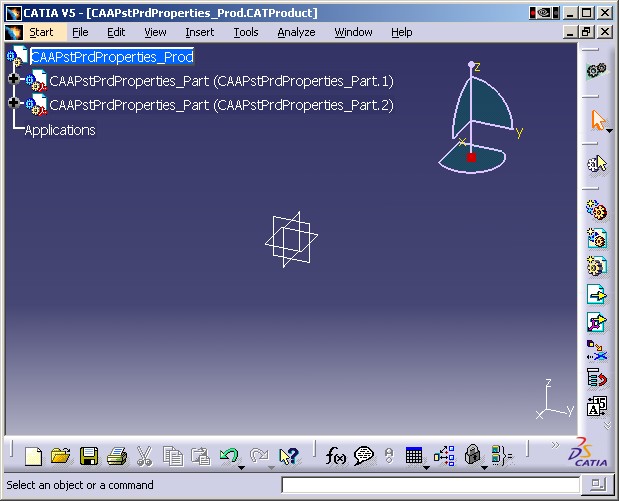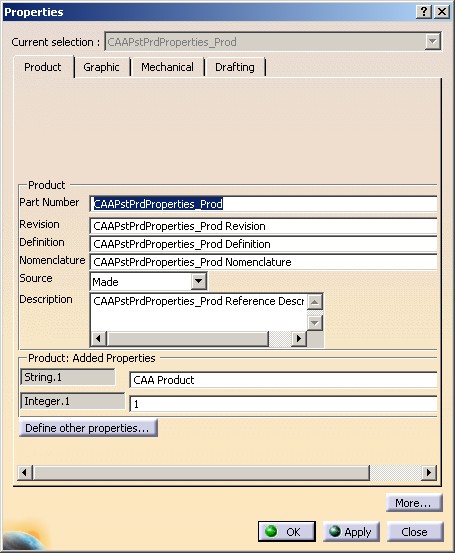
3D PLM PPR Hub Open Gateway |
Product Modeler |
Fetching a Product's Predefined PropertiesUsing the CATIPrdProperties Interface |
| Use Case | ||
AbstractThis article presents the CAAPstPrdProperties use case which illustrates how to retrieve a product's predefined properties. |
Using the CATIPrdProperties interface, the predefined properties of a product and its component can be retrieved. How to access the user defined properties is covered in Retrieving a Product's Properties (see reference [3]).
[Top]
CAAPstPrdProperties is a use case of the CAAProductStructure.edu framework that illustrates the ProductStructure framework capabilities.
[Top]
The goal of CAAPstPrdProperties is to demonstrate the CATIPrdProperties interface. It performs the following steps:
Below is the Product document that will be loaded in the use case. It can be found in
InstallRoot/CAAProductStructure.edu/CNext/resources/graphic/CAAPstPrdProperties_Prod.CATProduct

The CAAPstPrdProperties_Prod product consists of 2 parts: CAAPstPrdProperties_Part.1 and CAAPstPrdProperties_Part.2. Each component properties can be displayed using the contextual menu Properties. For example, CAAPstPrdProperties_Prod properties:

The code in the use case will traverse the product structure and displays each component properties producing the output below with the CAAPstPrdProperties_Prod.CATProduct.
The first section corresponding to the CAAPstPrdProperties_Prod, matches exactly the properties displayed in the Properties dialog above.
Properties of CAAPstPrdProperties_Prod:
Nomenclature: CAAPstPrdProperties_Prod Nomenclature
Revision: CAAPstPrdProperties_Prod Revision
Source: Made
Definition: CAAPstPrdProperties_Prod Definition
Reference Desc: CAAPstPrdProperties_Prod Reference Description
Instance Desc.:
Properties of CAAPstPrdProperties_Part (CAAPstPrdProperties_Part.1):
Nomenclature: CAAPstPrdProperties_Part Nomenclature
Revision: CAAPstPrdProperties_Part Revision
Source: Bought
Definition: CAAPstPrdProperties_Part Definition
Reference Desc: CAAPstPrdProperties_Part Reference Description
Instance Desc.: CAAPstPrdProperties_Part.1 Instance Description
Properties of CAAPstPrdProperties_Part (CAAPstPrdProperties_Part.2):
Nomenclature: CAAPstPrdProperties_Part Nomenclature
Revision: CAAPstPrdProperties_Part Revision
Source: Bought
Definition: CAAPstPrdProperties_Part Definition
Reference Desc: CAAPstPrdProperties_Part Reference Description
Instance Desc.: CAAPstPrdProperties_Part.2 Instance Description
|
[Top]
To launch CAAPstPrdProperties:
- input.CATProduct - the path to the supplied document whose path is InstallRoot/CAAProductStructure.edu/CNext/resources/graphic/CAAPstPrdProperties_Prod.CATProduct
[Top]
CAAPstPrdProperties code is located in the CAAPstPrdProperties.m module of the CAAProductStructure.edu framework.
[Top]
There are six logical steps in CAAPstPrdProperties:
We will now detail each of those sections:
[Top]
Generally, the first thing that is necessary in a batch program is the
creation of a new session. This is done using the Create_Session
global function. It is important not to forget to delete the session when the
program exits. Once the session is created, a Product document can be loaded
with CATDocumentServices::Open.
CATSession *pSession = NULL;
rc = ::Create_Session("CAA_PrdProp_Session", pSession);
...
//----------------------------------------------------------------------
// Opening an existing document with full path specified
//----------------------------------------------------------------------
CATDocument *pDoc = NULL;
rc = CATDocumentServices::Open(argv[1], pDoc);
...
|
[Top]
In order to work with a product structure within the Product document, it
is necessary to access the root product. This is done using the
GiveDocRoots method of CATIDocRoots which returns a list of all of
the roots within the document, the first one being the root product we are
looking for.
//----------------------------------------------------------------------
// Search for the document's root product
//----------------------------------------------------------------------
CATIDocRoots* piDocRootsOnDoc = NULL;
rc = pDoc->QueryInterface(IID_CATIDocRoots,
(void**) &piDocRootsOnDoc);
...
CATListValCATBaseUnknown_var* pRootProducts =
piDocRootsOnDoc->GiveDocRoots();
CATIProduct_var spRootProduct = NULL_var;
if (NULL != pRootProducts && pRootProducts->Size() > 0) {
spRootProduct = (*pRootProducts)[1];
...
} else {
cout << "Root product could not be obtained." << endl;
return 5;
}
|
[Top]
Once the Root Product is obtained, we need to query for its CATIProduct interface which is passed to the PrintPrdProperties function to display its properties.
//----------------------------------------------------------------------
// Get CATIProduct handle on the root product.
//----------------------------------------------------------------------
CATIProduct *piProductOnRoot = NULL;
if (spRootProduct != NULL_var)
rc = spRootProduct->QueryInterface(IID_CATIProduct,
(void**) &piProductOnRoot);
...
//----------------------------------------------------------------------
//Print the properties of the root product
//----------------------------------------------------------------------
PrintPrdProperties(piProductOnRoot);
|
[Top]
Next, we get the Root Product's components using GetAllChildren. For each of these children, we query their CATIProduct interface and pass it to PrintPrdProperties to display their properties.
//----------------------------------------------------------------------
//Get the root product's children
//----------------------------------------------------------------------
CATListValCATBaseUnknown_var* childrenList =
piProductOnRoot->GetAllChildren();
if (NULL == childrenList || childrenList->Size() <= 0) {
cout << "Could not retrieve Root product's children." << endl;
return 8;
}
...
CATIProduct_var spChild = NULL_var;
int childrenCount = childrenList->Size();
for (int i = 1; i <= childrenCount; i++) {
spChild = (*childrenList)[i];
//--------------------------------------------------------------
// Get CATIProduct handle on the child product
//--------------------------------------------------------------
CATIProduct *piChildProduct = NULL;
if (NULL_var != spChild) {
rc = spChild->QueryInterface(IID_CATIProduct,
(void**) &piChildProduct);
...
}
//--------------------------------------------------------------
//Print the properties of the child part
//--------------------------------------------------------------
PrintPrdProperties(piChildProduct);
if (NULL != piChildProduct) {
piChildProduct->Release();
piChildProduct = NULL;
}
}
delete childrenList;
childrenList = NULL;
|
[Top]
Before terminating the use case, we need to remove the document from the session before closing it.
//----------------------------------------------------------------------
// Remove opened document from session
//----------------------------------------------------------------------
rc = CATDocumentServices::Remove (*pDoc);
...
//----------------------------------------------------------------------
//Delete the session
//----------------------------------------------------------------------
rc = ::Delete_Session("CAA_PrdProp_Session");
...
|
[Top]
The properties of a component are accessed through the CATIPrdProperties interface. PrintPrdProperties begins by displaying the component part number and then its instance name if applicable. Then each property is obtained with a corresponding method, namely:
void PrintPrdProperties(CATIProduct *iInstanceProd)
{
HRESULT rc;
CATUnicodeString oValue;
if (NULL == iInstanceProd) return;
oValue = iInstanceProd->GetPartNumber();
cout << endl
<< "Properties of " << oValue.ConvertToChar();
rc = iInstanceProd->IsReference();
if (FAILED(rc)) {
rc = iInstanceProd->GetPrdInstanceName(oValue);
if (SUCCEEDED(rc))
cout << " (" << oValue.ConvertToChar() << ")";
}
cout << ":" << endl;
CATIPrdProperties_var spPrdProps(iInstanceProd);
if (NULL_var != spPrdProps) {
spPrdProps->GetNomenclature(oValue);
cout << " Nomenclature: " << oValue.ConvertToChar() << endl;
spPrdProps->GetRevision(oValue);
cout << " Revision: " << oValue.ConvertToChar() << endl;
CatProductSource oSource;
spPrdProps->GetSource(oSource);
switch (oSource) {
case catProductSourceUnknown:
oValue = "Unknown";
break;
case catProductMade:
oValue = "Made";
break;
case catProductBought:
oValue = "Bought";
break;
default:
oValue = "Undefined";
}
cout << " Source: " << oValue.ConvertToChar() << endl;
spPrdProps->GetDefinition(oValue);
cout << " Definition: " << oValue.ConvertToChar() << endl;
spPrdProps->GetDescriptionRef(oValue);
cout << " Reference Desc: " << oValue.ConvertToChar() << endl;
spPrdProps->GetDescriptionInst(oValue);
cout << " Instance Desc.: " << oValue.ConvertToChar() << endl;
} else {
cout << "None" << endl;
}
}
|
[Top]
This use case has demonstrated how to access to a component properties:
[Top]
| [1] | The Product Structure Model |
| [2] | Building and Launching a CAA V5 Use Case |
| [3] | Retrieving a Product's Properties. |
| [Top] | |
| Version: 2.1 [Aug 2004] | Document revised |
| Version: 2 [Feb 2004] | Reference added |
| Version: 1 [Sep 2003] | Document created |
| [Top] | |
Copyright © 2003, Dassault Systèmes. All rights reserved.